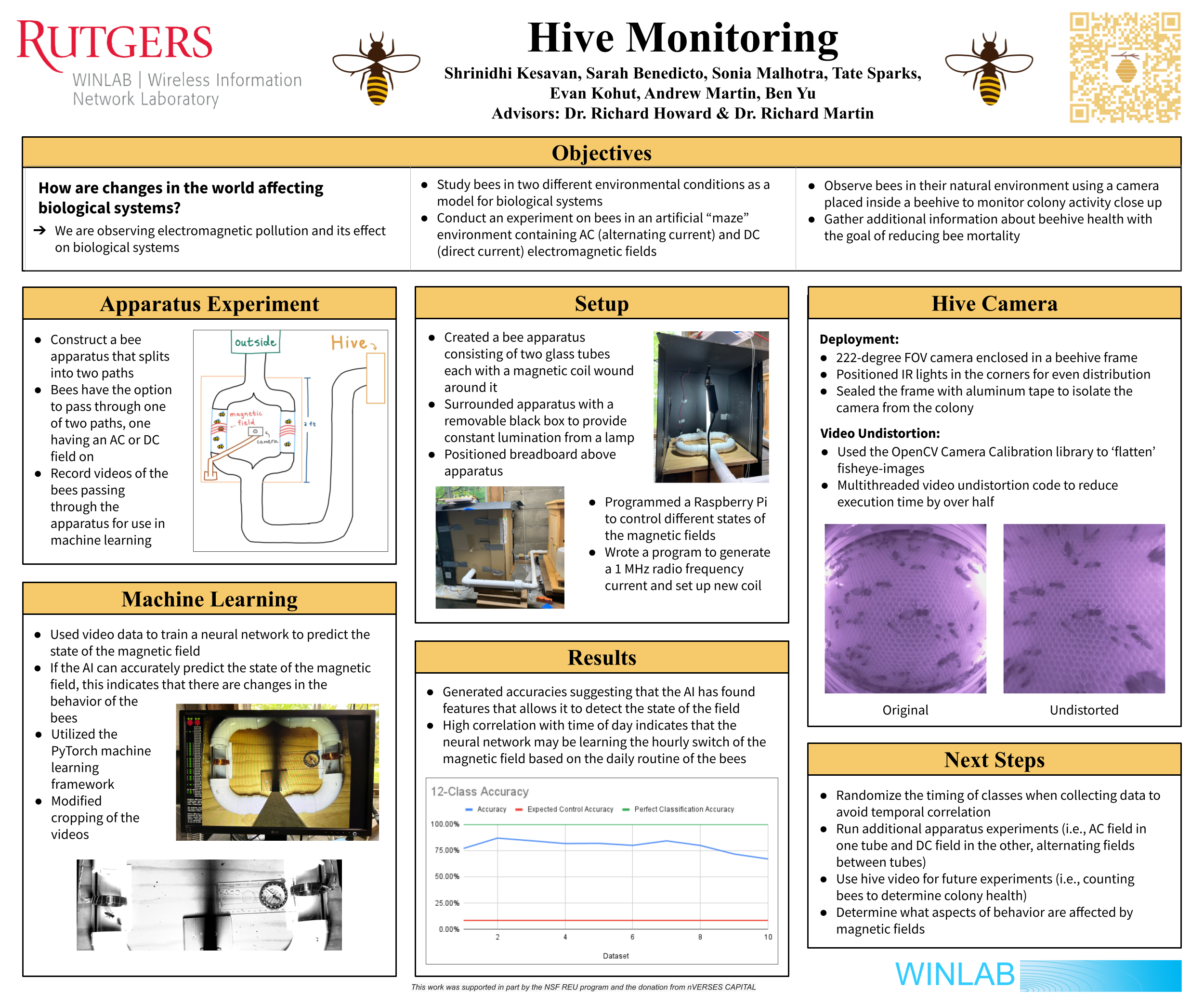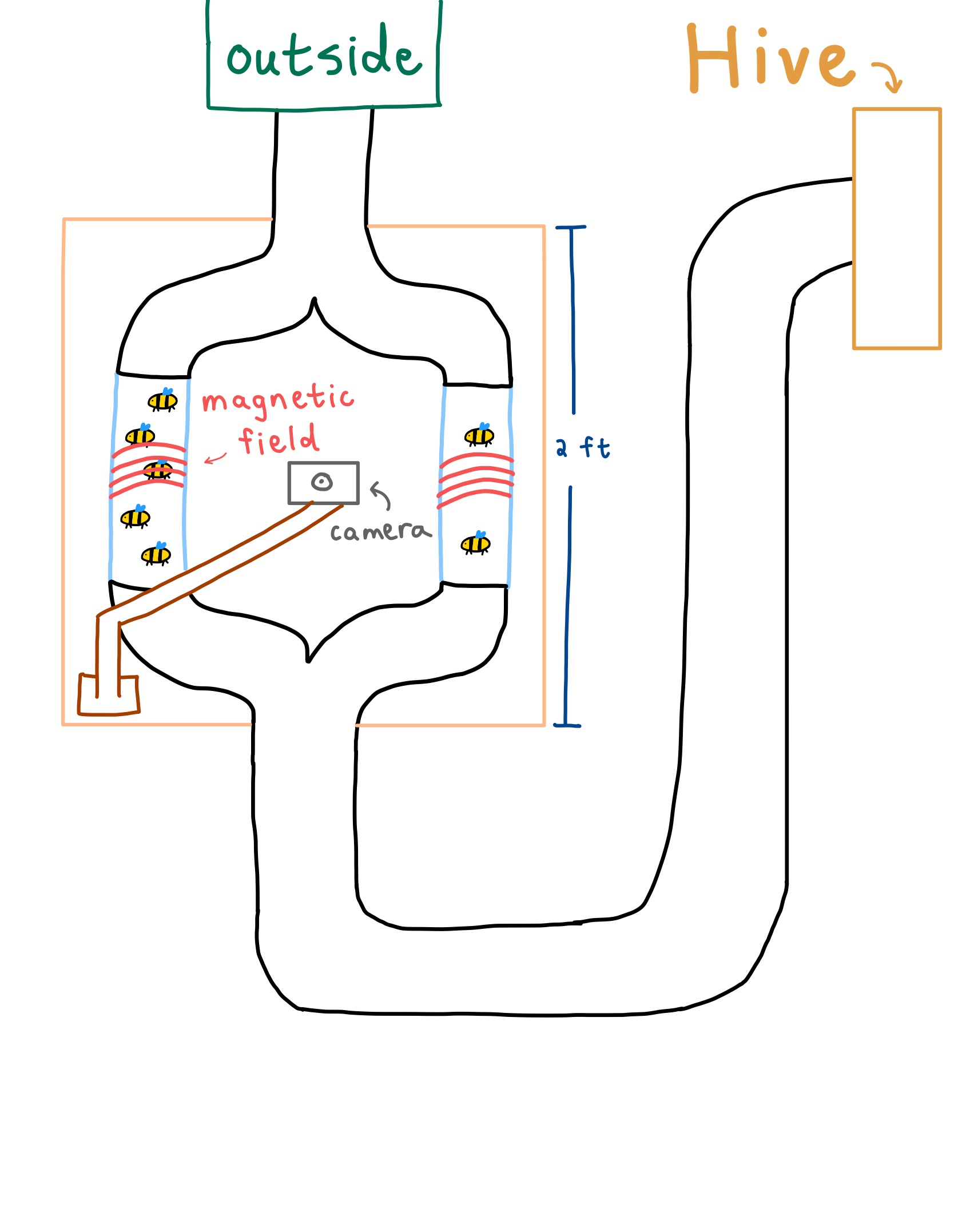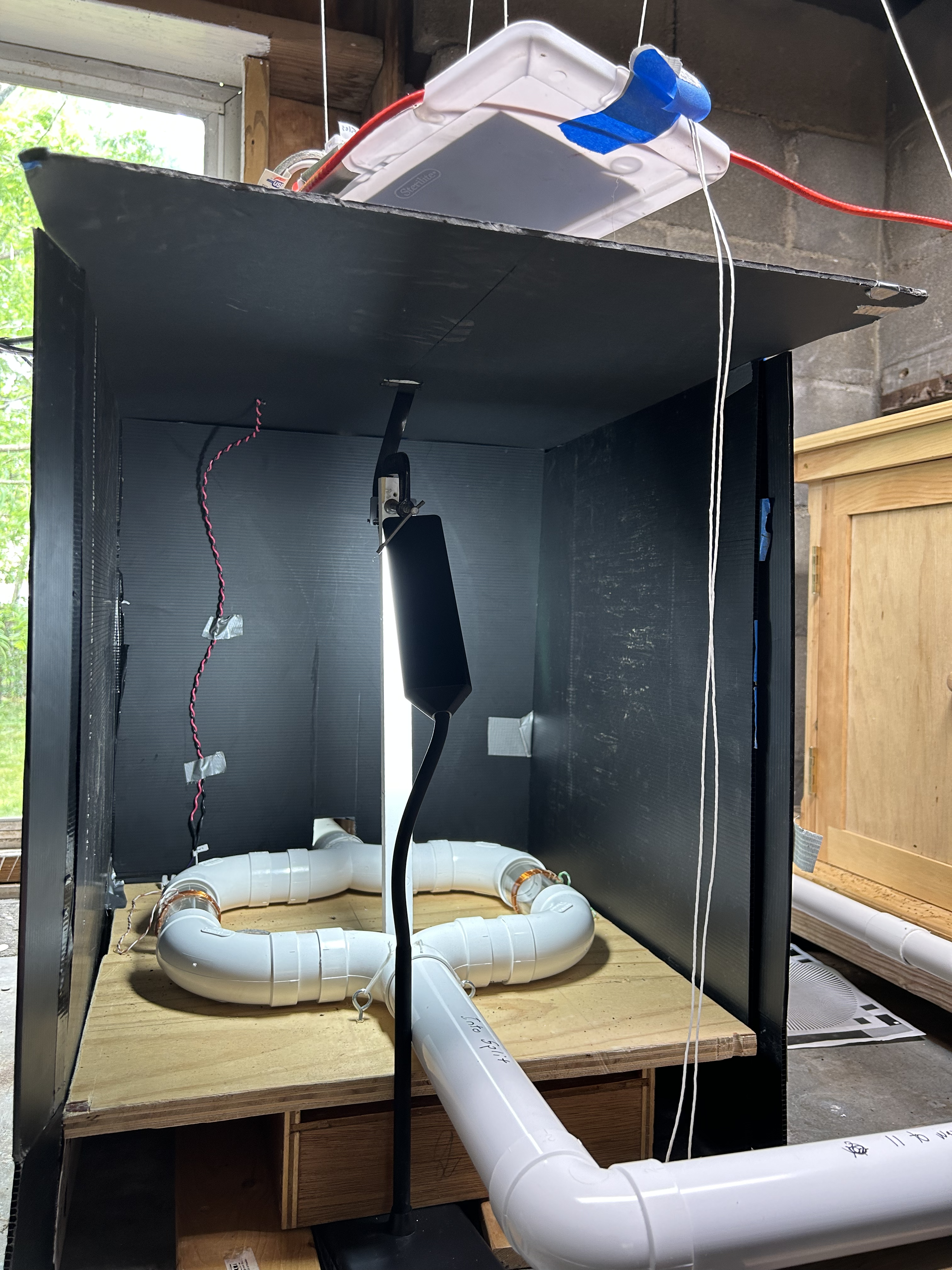Hive Monitoring
Advisors: Richard Howard, Richard Martin
Group Members: Tate Sparks, Shrinidhi Kesavan, Sarah Benedicto, Evan Kohut, Andrew Martin, Benjamin Yu, Sonia Malhotra
Overview
This study seeks to evaluate how bees are impacted by electromagnetic radio frequency (RF) waves emitted by humans. Similarly to how the lead epidemic has affected humans, radio frequency could prove to have an adverse effect on bee mortality.
Final Poster
Setup
Hive Camera
| A wide-angle camera and 4 IR lights are sealed inside a hive frame. A Raspberry Pi takes video and rectifies the fisheye image distortion. |
Progress
Week 1
Project Goal: The project's objective is to assess electromagnetic radio frequency (RF) impact on bees, particularly bee mortality, inspired by the lead epidemic's significance. It aims to examine how human-emitted RF affects bee populations and ecosystems.
Apparatus Mockup: Creating an apparatus in which the bees would come through from the tubes. The raspberry pi would be placed directly above the apparatus and the current would run through the apparatus.
Machine Learning Analysis: In the process of using pytorch libraries to test the machine learning scripts.
Week 2
Apparatus Construction: Modeled and figured out the correct sizing of it. The correct dimensions were found in order to cut and build the base. The glass tubes were cleaned and fixed. Lastly, a camera mount was established.
Raspberry Pi: ILAB was starting to get set up as well as running the machine learning scripts. Raspberry Pi Pinout was studied and code was written on it to control different states of the magnetic field.
Week 3
Data Collection: Videos of the bees were collected using the Raspberry Pi. The motion of the bees was observed depending on the different magnetic states. Machine learning would be used to analyze these videos.
Eliminating Extraneous Sources: Using white paper inside the box to distribute the light source evenly. Constructing a door for easier access into the setup.
Week 4
Control Data: There was an expected 50% accuracy. It was also determined that there could be an issue with the distribution of the data. A spreadsheet was created to amend this issue by manually verifying states.
Hive Camera: 222-degree fov
Week 5
Hive Camera: Used the OpenCV camera calibration library to correct the fisheye camera's image distortion.
Machine Learning: The neural network was being trained to detect behavioral responses from the bees and the magnetic field. PyTorch libraries were utilized to run the machine learning scripts. Accuracy indicates how well the neural network classified the videos.
Week 6
Alternating Current Circuits: Set up an alternating current by creating a set of programs that controlled the states on the raspberry pi.
Hive Camera: Began working on the deployment of the camera to the hive. Enclosed the camera with 2 IR lights in a hive frame. Sealed the frame with plastic poster board and aluminum tape. Doing so prevents the bees from chewing through to the camera. Placed Raspberry Pi in a weatherproof box and mounted it externally to the hive.
Frame Dataset Corrections: Encountered issues with the video frames when creating the dataset. But the code was modified to increment variables.
Week 7
Accomplishments:Fixed the issues with the cropping in the video. Manually created datasets to run. Soldered wires to the resistors, wrapped wire around the glass tubes in the bee apparatus and connected the soldered wires to the Raspberry pi. Ran the circuit and collected data on bee motion with the AC current.
Hive Camera: Two more IR lights were soldered in parallel for more even light distribution. The video capture code and undistortion code were combined. Used POE(Power Over Ethernet) to run power and data over 50 feet between the garage and the hive.
Week 8/9
Hive Camera: Multithreaded video undistortion script to reduce execution time by over half.
Presentations
Week 1 https://docs.google.com/presentation/d/1MtKp_Q4kYj8rK5n1t4eCN10S3px53kY4lWW0k9Y2XSs/edit?usp=sharing
Week 2 https://docs.google.com/presentation/d/1ADvK4neFgE9My_yHJRX4hd7cKdQ70z3zusmd4PjSqkE/edit?usp=sharing
Week 3 https://docs.google.com/presentation/d/1Gh0W6tGCZ73KXImxl8CZYhpTA0nsuiyrOs0CsUNcRbU/edit?usp=sharing
Week 4 https://docs.google.com/presentation/d/1pCnK6VBakeFyNgBYtZI9LUvJrwMotd29TzDQ_zN5YRw/edit?usp=sharing
Midway Progress
https://docs.google.com/presentation/d/1BGfHoxGJ2W533OdZRhyn6lgF7OyR_DEVRs87jQCrT-Y/edit?usp=sharing
Week 6
https://docs.google.com/presentation/d/1uop2ytlSdMh5aFQvZgZPGiPWpo7b0tTZ4oaqu9TswJc/edit?usp=sharing
Week 7
https://docs.google.com/presentation/d/1k87TEy9SG5kleGvpUR2P4fqSRZFa3vHKRRMU991VSjY/edit?usp=sharing
Final Presentation
https://docs.google.com/presentation/d/14Aqs3DC1h3pirV34ZxkdPSACwGZpx6Noy8XR7-Kb6NI/edit?usp=sharing
Attachments (6)
- experiment diagram.png (672.8 KB ) - added by 3 years ago.
- apparatus box.png (14.1 MB ) - added by 3 years ago.
-
7-31.mp4
(10.9 MB
) - added by 2 years ago.
Video from inside the hive
- Screenshot 2023-08-09 at 11.25.03 AM.png (66.1 KB ) - added by 2 years ago.
-
Unknown
(8.4 KB
) - added by 2 years ago.
hive cam
- Hive Monitoring Final Poster.pptx.png (2.0 MB ) - added by 2 years ago.



